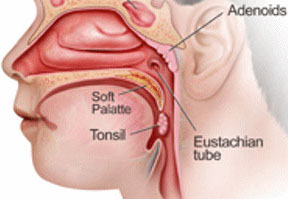Tonsillitis & Adenoiditis

Tonsils and adenoids are similar to the lymph nodes or “glands” found in the neck, groin, and armpits. They are a small part of the body’s first line of defense as part of the immune system. Tonsils are the two round lumps in the back of the throat. Adenoids sit high in the throat behind the nose and the roof of the mouth (soft palate), and are not visible through the mouth or nose without special instruments. These tissues “sample” bacteria and viruses that enter the body through the mouth or nose, but they sometimes become infected.
Tonsillitis most often occurs in children, but rarely in those younger than two years old. These infections can be viral (more common in younger patients) or bacterial (typically in children aged 5-15 years). Infectious mononucleosis due to EBV should be considered in an tonsil check adolescent or younger child with acute tonsillitis, presenting when tender cervical, axillary (armpit), and/or groin nodes, as well as severe lethargy, malaise, and low-grade fever.
An inadequately treated or severe episode of tonsillitis can lead to a peritonsillar abscess, which is a collection of pus between the tonsil and the constrictor muscle of the throat. This is usually seen in young adults but can occur occasionally in children. The tonsils can also become chronically infected with formation of foul-smelling white deposits within the crypts (pockets) of the tonsils. These can be associated with symptoms of halitosis (bad breath) and chronic sore throat.
Removal of the tonsils (tonsillectomy) and/or adenoids (adenoidectomy) may be recommended if there is a history of chronic or recurring infections despite antibiotic therapy, and/or difficulty breathing due to enlarged tonsils and/or adenoids. Such obstruction to breathing causes snoring and disturbed sleep that leads to daytime sleepiness, and may even cause behavioral or school performance problems in some children. Chronic infections of the adenoids can affect other areas such as the eustachian tube – the passage between the back of the nose and the inside of the ear. This can lead to frequent ear infections and buildup of fluid in the middle ear that may cause temporary hearing loss. A peritonsillar abscess may need more urgent treatment to drain the abscess.

